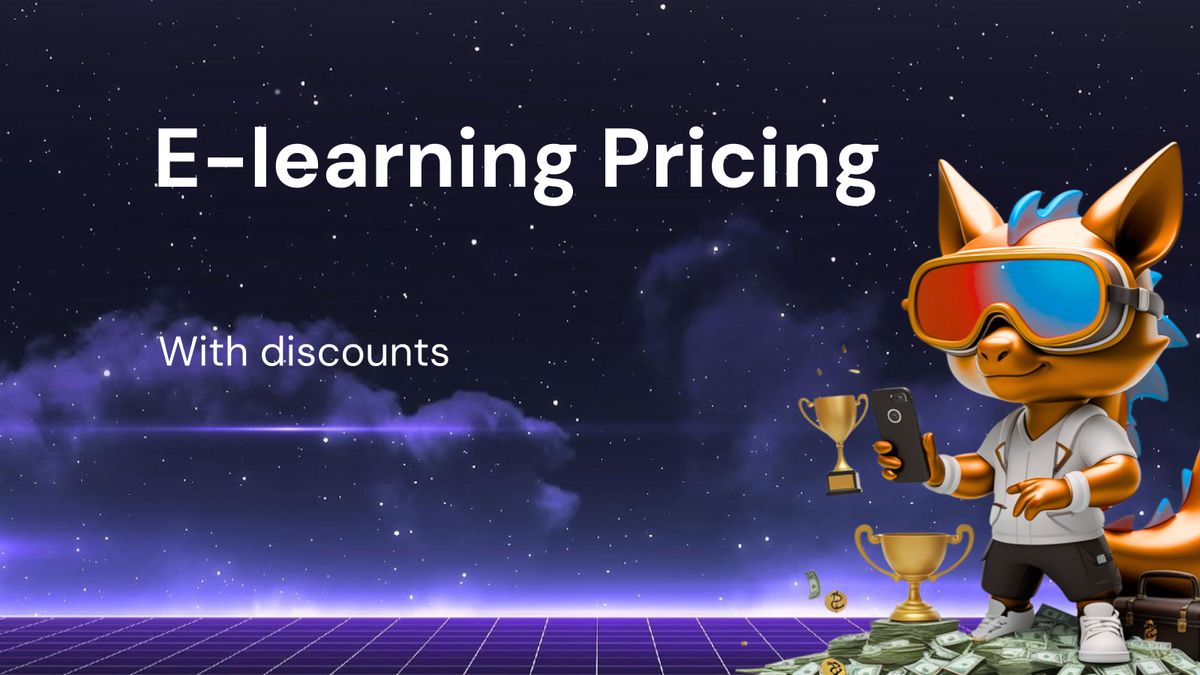Pricing Breakdown for e-learning platforms with discounts

Pricing Breakdown for e-learning Platforms with Discounts
The e-learning landscape is vast and ever-evolving, offering a plethora of platforms catering to diverse learning needs and budgets. Navigating this landscape can be daunting, especially when trying to decipher pricing structures and identify potential discounts. This article provides a comprehensive breakdown of e-learning platform pricing models, offering practical tips and guidance on how to find the best deals without compromising on quality. We aim to equip you with the knowledge to make informed decisions and maximize your learning investment.
Understanding the Evolving E-Learning Landscape
Before diving into the specifics of pricing, it's crucial to understand the fundamental shifts occurring in the e-learning industry. Traditional classroom learning is increasingly being supplemented, and in some cases replaced, by online platforms. This shift is driven by factors such as:
- Accessibility: E-learning removes geographical barriers, allowing individuals to learn from anywhere in the world with an internet connection.
- Flexibility: Learners can study at their own pace and on their own schedule, accommodating busy lifestyles and individual learning styles.
- Cost-Effectiveness: E-learning can often be more affordable than traditional education, eliminating costs associated with commuting, accommodation, and physical learning materials.
- Personalization: Many e-learning platforms offer personalized learning paths, adapting to the individual's knowledge level and learning preferences.
- Variety: E-learning platforms offer a vast range of courses and subjects, catering to diverse interests and career goals.
These factors have fueled the growth of the e-learning market, resulting in a wide array of platforms, each with its own pricing structure and offerings. Understanding these various models is the first step to finding the best value for your money.
Common E-Learning Platform Pricing Models
E-learning platforms employ various pricing models, each with its own advantages and disadvantages. Let's examine the most common models:
- Subscription-Based Model: This is perhaps the most prevalent model. Learners pay a recurring fee (monthly or annually) to access a platform's entire library of courses or a specific subset.
- Pros: Provides access to a broad range of content, often updated regularly. Encourages continuous learning. Can be cost-effective if you plan to take multiple courses.
- Cons: If you only need one or two specific courses, the subscription fee might be higher than paying for individual courses. You might end up paying for content you don't use. Requires consistent engagement to justify the cost.
- Examples: Coursera Plus, Skillshare, LinkedIn Learning, MasterClass.
- Pay-Per-Course Model: Learners pay a one-time fee for access to a specific course. Once purchased, the course is usually accessible indefinitely (though access policies can vary).
- Pros: Ideal if you only need to learn a specific skill or subject. Offers greater control over spending. No recurring fees.
- Cons: Can be more expensive if you plan to take multiple courses. No access to a wider library of resources or community features unless specifically included.
- Examples: Udemy, individual courses on Coursera or edX (outside of subscription offerings).
- Freemium Model: The platform offers a limited selection of free courses or resources, with the option to upgrade to a paid subscription for access to premium content and features.
- Pros: Allows you to try out the platform before committing to a paid subscription. Provides access to valuable content for free.
- Cons: Free content may be limited in scope or quality. Paid subscriptions can be expensive.
- Examples: Many MOOC platforms like Coursera, edX, and FutureLearn offer free courses with optional paid certificates.
- Credit-Based Model: Learners purchase credits that can be redeemed for individual courses or resources. The cost of a course is determined by the number of credits required.
- Pros: Offers flexibility in choosing courses and resources. Allows you to control your spending.
- Cons: Can be difficult to estimate the overall cost of learning. Credits may expire if not used within a certain timeframe.
- Examples: Some smaller or niche e-learning platforms may utilize this model.
- Cohort-Based Courses: These courses run on a fixed schedule with a specific start and end date, often incorporating live sessions and group projects. The pricing is typically a one-time fee for the entire course.
- Pros: Provides a structured learning environment with interaction with instructors and peers. Often includes mentorship and feedback.
- Cons: Requires commitment to a specific schedule. Can be more expensive than self-paced courses.
- Examples: Platforms like altMBA, Section4, and various online bootcamps.
- Enterprise Solutions: Tailored learning solutions designed for organizations to train their employees. Pricing is typically based on the number of users and the specific features required.
- Pros: Customizable learning experiences designed to meet specific organizational needs. Provides centralized tracking and reporting.
- Cons: Can be expensive, especially for small businesses. Requires dedicated resources for implementation and management.
- Examples: Platforms like TalentLMS, Docebo, and SAP Litmos.
Factors Influencing E-Learning Platform Pricing
Several factors influence the pricing of e-learning platforms. Understanding these factors can help you evaluate whether a particular platform is worth the investment.
- Content Quality and Depth: Courses developed by renowned universities, industry experts, or experienced instructors typically command higher prices. In-depth courses with comprehensive materials and hands-on projects are also generally more expensive.
- Instructor Credentials: Courses taught by recognized experts in their field tend to be priced higher. Instructor experience and reputation play a significant role in perceived value.
- Platform Features and Technology: Platforms with advanced features like personalized learning paths, interactive simulations, virtual labs, and robust assessment tools often charge more.
- Accreditation and Certification: Courses that lead to recognized certifications or academic credits tend to be more expensive than non-accredited courses.
- Community and Support: Platforms that offer strong community features, such as discussion forums, peer-to-peer learning, and dedicated support teams, may justify higher prices.
- Brand Reputation: Established and well-known e-learning platforms often command higher prices due to their brand recognition and perceived quality.
- Course Length and Duration: Longer and more comprehensive courses typically cost more than shorter, introductory courses.
- Geographic Location: Prices can vary depending on the target audience and the cost of living in different regions.
Finding E-Learning Platform Discounts and Deals
While e-learning can be more affordable than traditional education, it's still essential to seek out discounts and deals to maximize your savings. Here are some effective strategies:
- Look for Promotional Offers: Many e-learning platforms offer promotional discounts throughout the year, especially during holidays, back-to-school season, and special events. Keep an eye on their websites, social media channels, and email newsletters for announcements.
- Utilize Free Trial Periods: Most subscription-based platforms offer free trial periods, allowing you to explore the content and features before committing to a paid subscription. Take advantage of these trials to assess whether the platform meets your needs.
- Consider Bundled Packages: Some platforms offer bundled packages that include multiple courses or resources at a discounted price. These packages can be a great value if you're interested in learning multiple related subjects.
- Explore Group Discounts: If you're part of an organization or group of individuals interested in taking the same course, inquire about group discounts. Many platforms offer discounts for bulk purchases.
- Check for Student or Educator Discounts: Some platforms offer discounts for students or educators. You may need to provide proof of enrollment or employment to qualify.
- Search for Coupon Codes: Before making a purchase, search online for coupon codes that may be applicable to the e-learning platform you're considering. Numerous websites and browser extensions specialize in finding and sharing coupon codes.
- Utilize Cashback Programs: Some cashback programs offer rebates on purchases made through e-learning platforms. Check if your credit card or other loyalty programs offer cashback rewards for online learning.
- Take Advantage of Limited-Time Offers: Many platforms run limited-time offers that provide significant discounts on courses or subscriptions. These offers are often time-sensitive, so act quickly if you find a deal that interests you.
- Consider Free Courses: Many platforms offer a selection of free courses that provide valuable learning opportunities without any cost. While free courses may not be as comprehensive as paid courses, they can be a great way to learn new skills or explore different subjects.
- Follow E-Learning Platforms on Social Media: Following e-learning platforms on social media can keep you informed about upcoming promotions, discounts, and special offers.
- Sign Up for Email Newsletters: Subscribing to email newsletters from e-learning platforms ensures that you receive timely updates on new courses, promotions, and exclusive discounts.
- Negotiate with the Platform (Especially for Enterprise Solutions): If you're an organization looking for an enterprise e-learning solution, don't hesitate to negotiate the pricing with the platform provider. You may be able to secure a better deal by discussing your specific needs and budget.
Evaluating the Value Proposition: Beyond the Price Tag
While finding discounts is important, it's crucial to evaluate the overall value proposition of an e-learning platform before making a decision. Consider the following factors:
- Learning Objectives: Does the platform offer courses that align with your specific learning objectives and career goals?
- Content Relevance and Accuracy: Is the content up-to-date, relevant, and accurate? Look for courses developed by reputable instructors or organizations.
- Learning Experience: Is the platform user-friendly and engaging? Does it offer interactive elements, such as quizzes, assignments, and discussion forums?
- Support and Resources: Does the platform provide adequate support and resources, such as technical assistance, learning materials, and community forums?
- Reputation and Reviews: What do other learners say about the platform and its courses? Read reviews and testimonials to get a sense of the quality and effectiveness of the learning experience.
- Accreditation and Recognition: Is the platform accredited or recognized by relevant industry organizations? Does it offer certifications that are valued by employers?
- Return on Investment (ROI): Consider the potential return on investment (ROI) of the e-learning platform. Will the skills and knowledge you gain from the platform help you advance your career, increase your earning potential, or achieve your personal goals?
Specific Search Instructions for Finding Discounts
Here are some specific search instructions you can use to find discounts on e-learning platforms using search engines like Google:
- Platform Name + "Discount Code": Example: "Coursera Discount Code"
- Platform Name + "Promo Code": Example: "Udemy Promo Code"
- Platform Name + "Coupon Code": Example: "Skillshare Coupon Code"
- Platform Name + "Student Discount": Example: "LinkedIn Learning Student Discount"
- Platform Name + "Limited Time Offer": Example: "MasterClass Limited Time Offer"
- "E-learning Discounts": This broader search can reveal articles and websites dedicated to aggregating e-learning deals.
- "Online Course Discounts": Similar to the above, but with a focus on course-specific deals.
- "Best E-learning Deals": This can lead you to comparison articles and curated lists of the best current offers.
Remember to check multiple sources and verify the validity of any coupon codes before making a purchase. Also, be wary of websites that appear to be offering unrealistic discounts, as they may be scams.
Conclusion: Making Informed Decisions in the E-Learning Marketplace
The e-learning landscape offers a wealth of opportunities for individuals to learn new skills, advance their careers, and achieve their personal goals. By understanding the various pricing models, factors influencing pricing, and strategies for finding discounts, you can make informed decisions and maximize your learning investment. Remember to prioritize value over price, and choose a platform that aligns with your specific learning objectives and needs. By taking a proactive and informed approach, you can unlock the full potential of e-learning and achieve your learning aspirations.




